Most sales teams overlook the importance of sales enablement in improving sales training and development, as well as rep performance. See how to inform yours with these sales enablement statistics.
22 Sales Enablement Statistics You Need to Know
This article is part of a larger series on Sales Management.
Sales enablement tools, like explainer videos, microsites, e-books, and other online learning materials, empower salespeople with the right knowledge and skills to engage and sell more effectively. Training reduces sales friction like misaligned goals and lack of skills, leading reps to convert leads and close more deals. Guided by these 22 sales enablement statistics, train your reps to keep your sales pipeline full, improve efficiency, and boost your business revenue.
Highlights
- 90% of sales organizations have a dedicated sales enablement program, person, or function.
- Sales enablement tool use has increased 48% in 2024.
- 81% of sales organizations agree that sales enablement improves revenue teams’ efficiency.
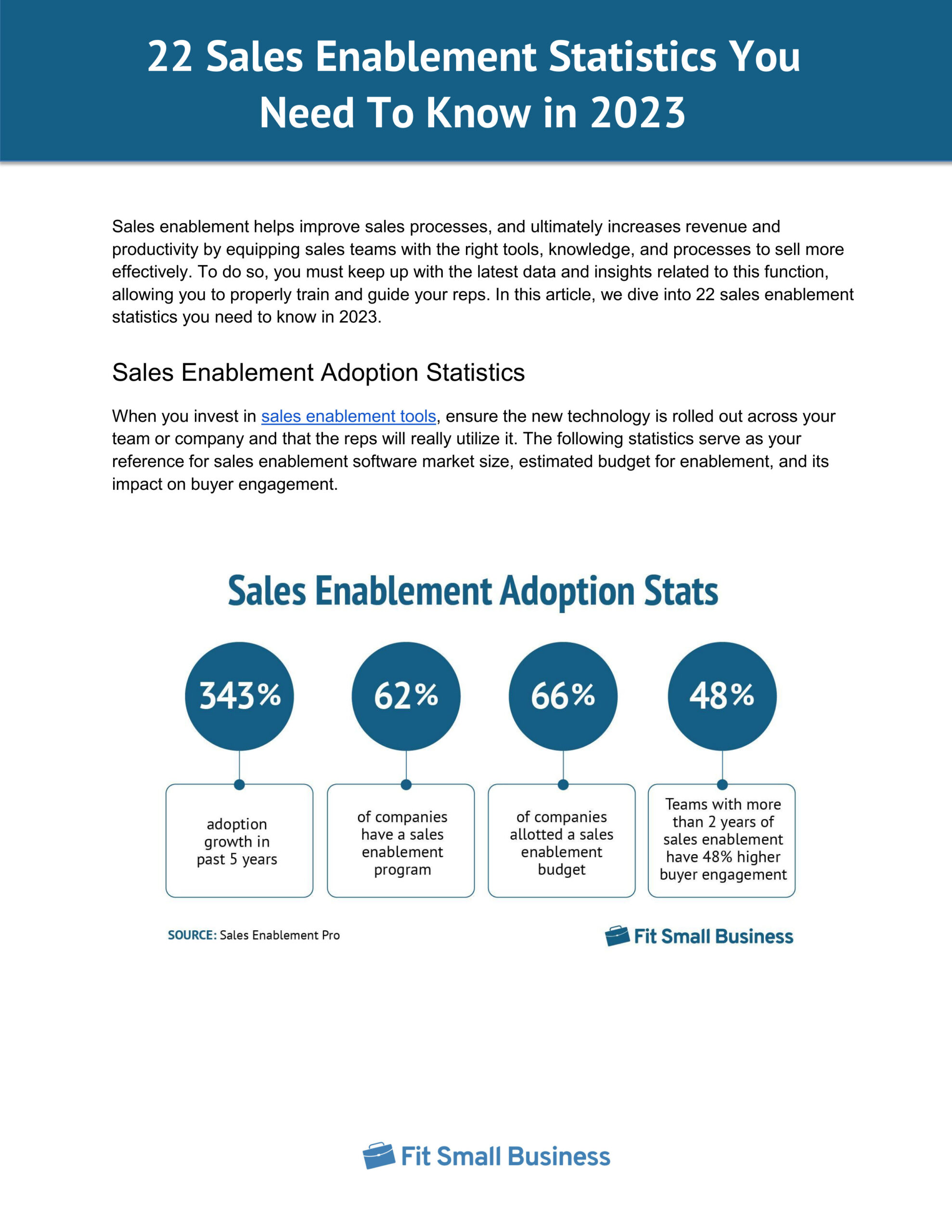
Thank you for downloading!
💡 Quick Tip:
As part of your sales strategy, give your sales team the tools to automate parts of your sales processes and to collaborate effectively with robust customer relationship management (CRM) software.
Use a CRM like Freshsales to help your sales team collaborate on deals and organize your sales operations.
Sales Enablement Adoption Statistics
When you invest in sales enablement tools, ensure the new technology is rolled out across your team or company and that the reps will really use it. The following statistics serve as your reference for sales enablement software market size, estimated budget for enablement, and its impact on buyer engagement.
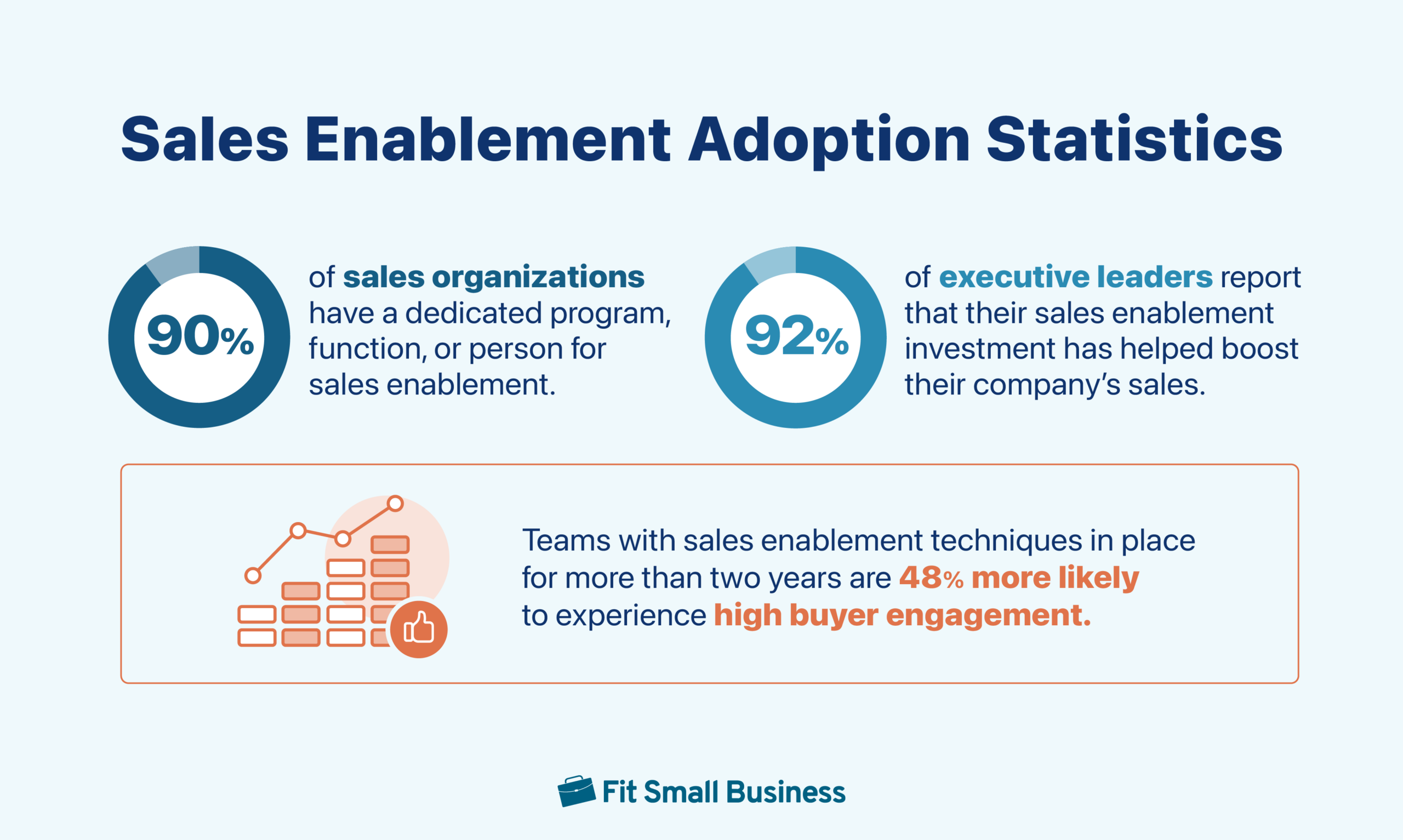
1. 90% of sales organizations have a dedicated program, function, or person for sales enablement.
Takeaway: This statistical data shows that more and more companies realize the business value of sales enablement. If you don’t have a program, function, or person yet, be sure to get one since so many businesses are benefiting from it. You can launch a formal onboarding campaign for sales efficiency and lead by example by showing your reps how to use new sales technology to convince them to adopt it quickly.
(Source: Sales Enablement Pro)
2. 92% of executive leaders report that their sales enablement investment has helped boost their company’s sales.
Takeaway: This study also shows that 84% of executive leaders commit the same level of investment or increase their sales enablement budgets in 2024. Hence, we can say that many key decision-makers adopt sales enablement because of foreseen business benefits such as efficiency, productivity, and higher revenue. So, it’s never too late to kick-start your sales enablement for your small business.
(Source: Sales Enablement Pro)
3. Teams with sales enablement techniques in place for more than two years are 48% more likely to experience high buyer engagement.
Takeaway: Enablement supports sales teams’ efforts in cultivating and optimizing customer interactions. Its profound impact on buyer engagement is backed by data. This should serve as a solid motivation for sales companies to initiate an enablement process or maintain the one they currently have in place. So, review your sales enablement strategies regularly to attract more potential customers for your small business.
(Source: Sales Enablement Pro)
Sales Enablement Statistics: Impact on Win Rates
Win rates represent the percentage of deals sales reps close in a given reporting period. Higher win rates are one of the benefits of sales enablement. The following sales enablement stats show how equipping your reps with the proper knowledge, skills, and tools can contribute to their increase in sales.
4. Practitioners who leverage a sales enablement platform report win rates that are 9% higher than those who do not.
Takeaway: A 9% difference in win rates may seem like a small number, but it reflects the significant impact of enablement on reps’ ability to close deals successfully. It also indicates the effectiveness of your sales messaging. Higher win rates mean more sales and revenue growth for your company.
(Source: Sales Enablement Pro)
5. Organizations leveraging sales engagement technology are 46% more likely to boost their win rate.
Takeaway: This report supports sales technology as a buyer engagement optimizer. Building a personalized microsite or digital sales room creates a shared space for reps and customers to meet together and consolidate all the resources needed throughout the buying process. This creates more connected conversations and a personal touch, which increases the trust rating and win rate.
(Source: Sales Enablement Pro)
Sales Enablement Internal Drivers Statistics
Sales organizations and teams encounter friction caused by different factors such as evolving market conditions and buyer expectations. Take note of the sales enablement stats below to anticipate your reps’ challenges. That way, you will be better prepared to deal with these issues as they arise.
6. 81% of organizations agree that sales enablement helps improve revenue teams’ efficiency.
Takeaway: This shows that if teams focus on boosting sales productivity and consistent agent performance, sales enablement can help drive sales efficiency. Well-crafted sales enablement content assists sales reps in communicating with potential customers confidently. This makes them subject-matter experts and product specialists, providing accurate information about their offers to win more sales.
(Source: Sales Enablement Pro)
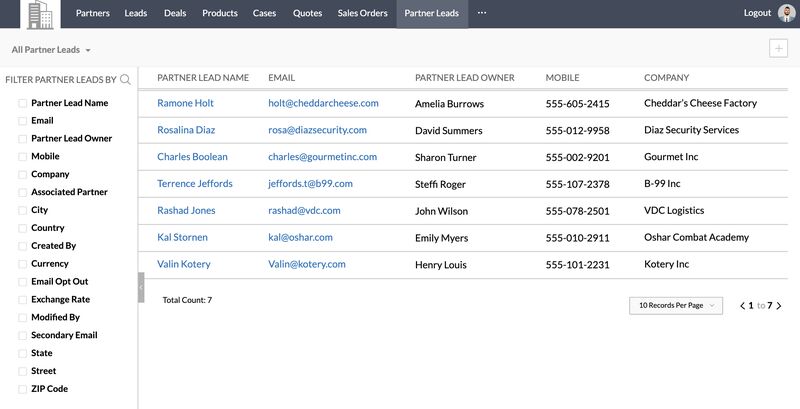
Zoho CRM empowers customers, partners, and vendors with Portals. (Source: Zoho CRM)
7. 37% of sales organizations are struggling to increase their revenue with minimal costs.
Takeaway: Other top challenges organizations face include sales velocity and ongoing effective coaching—all affecting the economic landscape of today’s businesses. Sales organizations may find creating and implementing sales enablement programs costly. Sales enablement tools also have upfront costs, but your small business can benefit from long-term savings and sales revenue by employing well-trained reps.
(Source: Sales Enablement Pro)
Sales Enablement Stats: Revenue Performance
The dynamics of sales have certainly changed in light of the pandemic and lockdowns that happened in the last couple of years. The sales enablement market has grown, and many businesses have adopted remote sales strategies. Take a look at the data below to appreciate the impact of enablement technology on the revenue performance of sales teams.
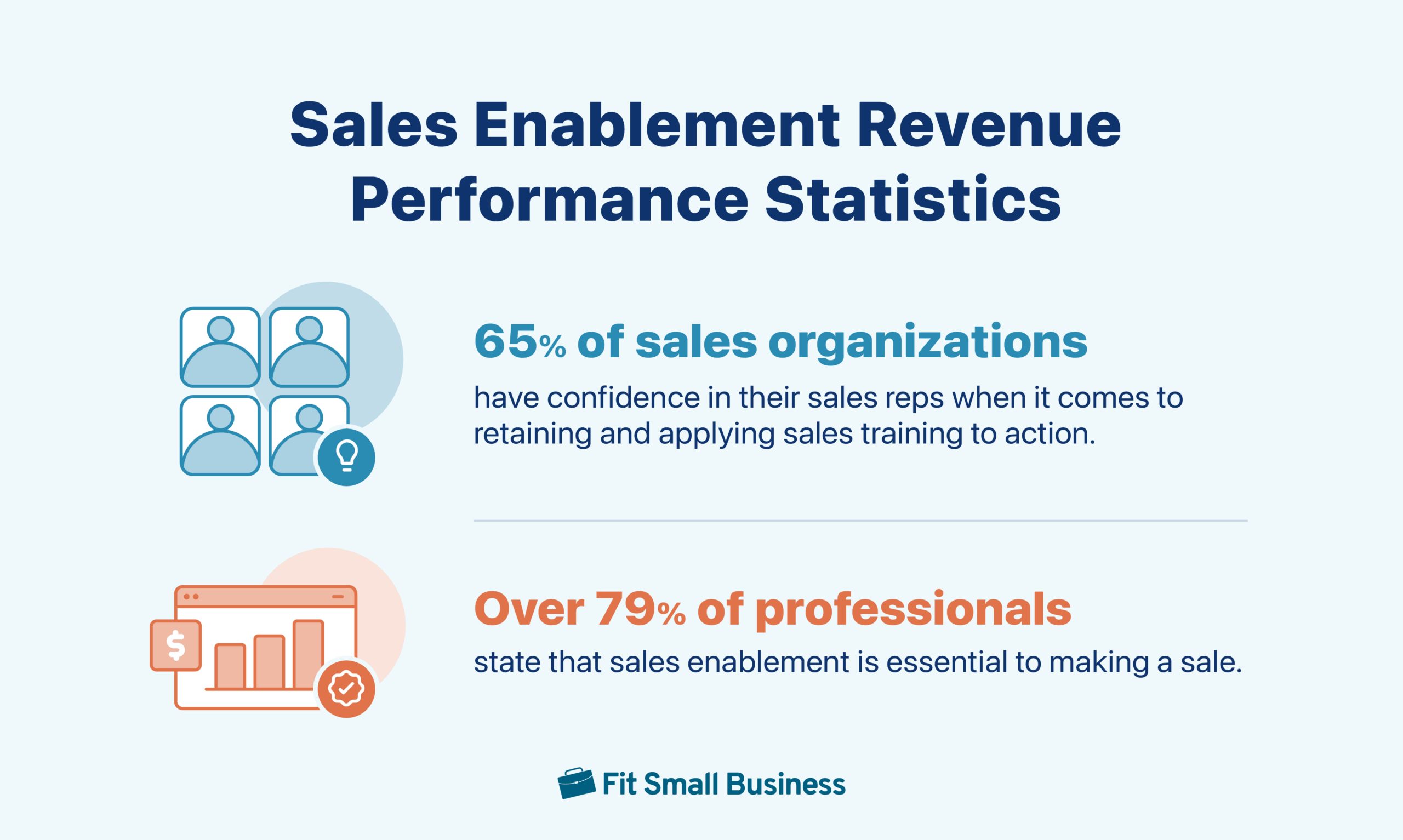
8. 65% of sales organizations have confidence in their sales reps when it comes to retaining and applying sales training to action.
Takeaway: Sales training closes gaps in the sales process. Specifically, sales enablement training reinforces desired behaviors with practice scenarios, effectively driving behavior change among sales reps. Well-trained sales reps have enhanced hard and soft skills, so they’re more likely to engage with customers better. They can convert prospects quickly and close more deals, positively impacting revenue growth.
(Source: Sales Enablement Pro)
9. Over 79% of professionals state that sales enablement is essential to making a sale.
Takeaway: Sales reps can improve buyer interactions with more relevant sales content to make informed buying decisions. Win more deals by leveraging market research, customer testimonials, product demos, and social media. By doing so, sellers become more productive and focus more on customers and closing deals, directly impacting overall business revenue.
(Source: HubSpot)
Sales Enablement Tools Statistics
Virtual selling has drastically transformed the dynamics of sales. It is an essential aspect of digital transformation, especially for business-to-business (B2B) companies, to avoid being left behind by their competitors. Hence, more businesses are investing in technology to support their reps in remote selling activities. Below are a few sales enablement stats that point you to the most crucial tools and automation for sellers.
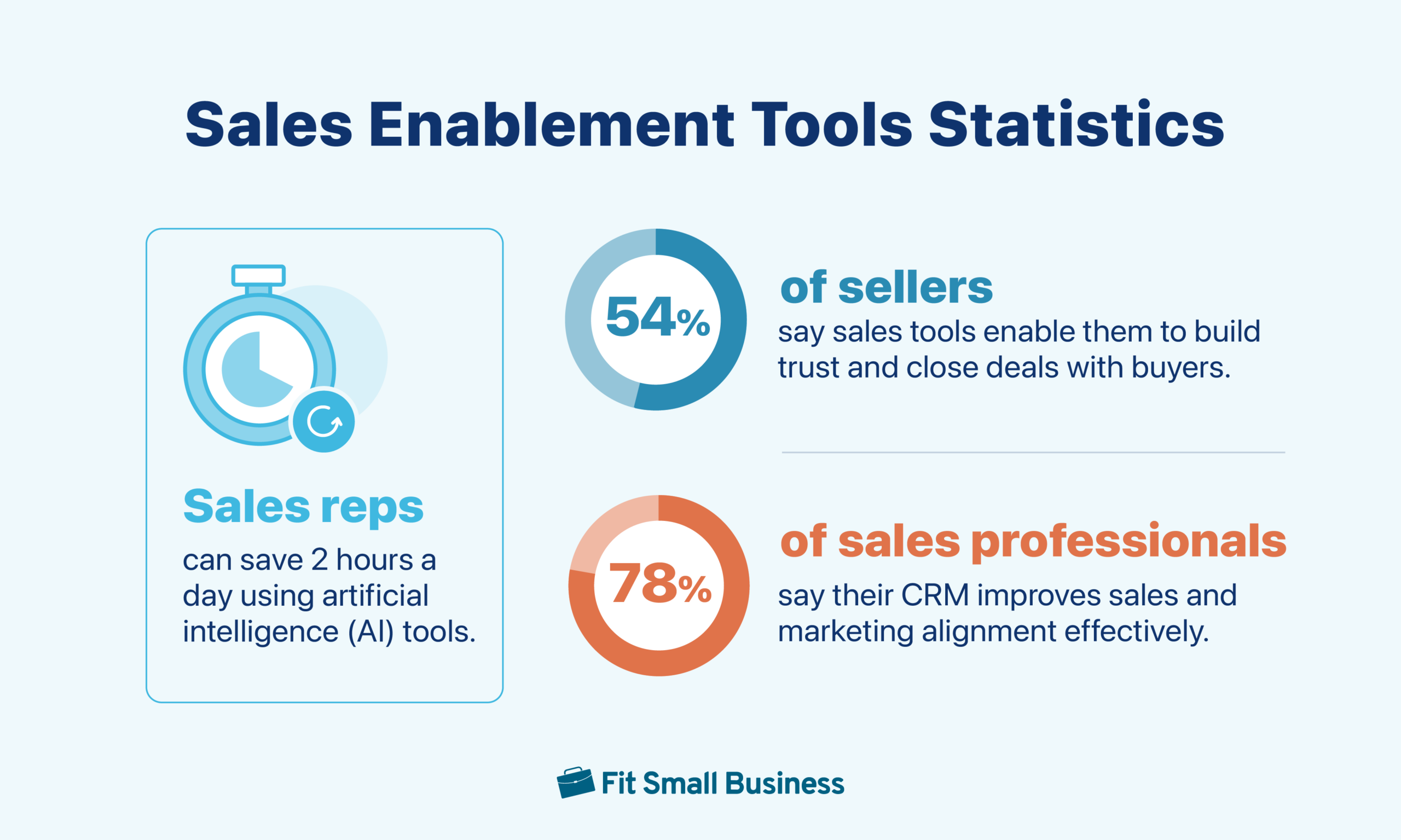
10. Sales reps can save 2 hours a day using artificial intelligence (AI) tools.
Takeaway: Many CRM software programs with AI tools can generate quotes, assign reps, and score leads. AI automation enhances sales rep productivity with sales plan templates. It also helps companies save valuable time and money by reducing the need to perform tasks manually.
(Source: HubSpot)
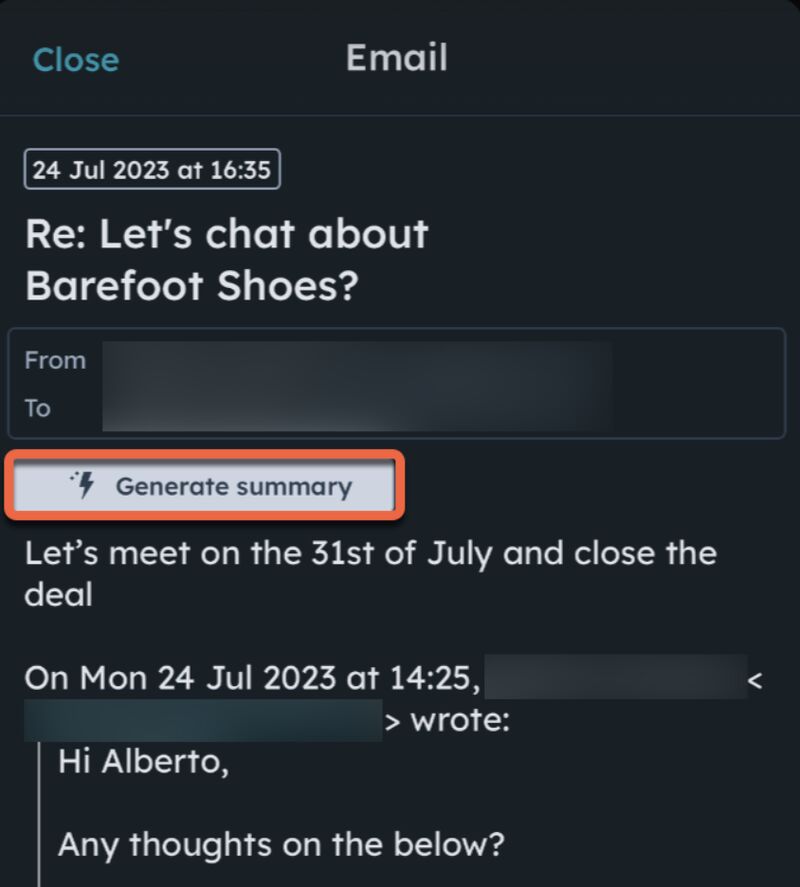
HubSpot’s AI assistant helps sales reps generate content, like a chat summary. (Source: HubSpot)
11. 54% of sellers say sales tools enable them to build trust and close deals with buyers.
Takeaway: Sellers establish trust with buyers during face-to-face meetings, trade shows, and dinners. Many sellers are also leveraging sales technology to understand what their potential customers need. This includes sales enablement tools like sales playbooks and templates, streamlining their workflows.
(Source: LinkedIn)
12. 78% of sales professionals say their CRM improves sales and marketing alignment effectively.
Takeaway: Customer relationship management (CRM) software, like Freshsales, can help sales and marketing communicate and collaborate. Sales enablement tools in CRMs like performance tracking, content management, and sales management features enable sales reps to connect with marketers. As a result, reps can determine the most qualified leads and focus more on selling instead of spending time on repetitive tasks.
(Source: HubSpot)
Sales Enablement Content Statistics
There are various types of content salespeople use to address prospects’ concerns, answer questions about their product or service, and convert prospects into customers. Enablement personnel are tasked with creating these materials for the sales team. Check out the data below to see which are the most commonly used and the most effective.
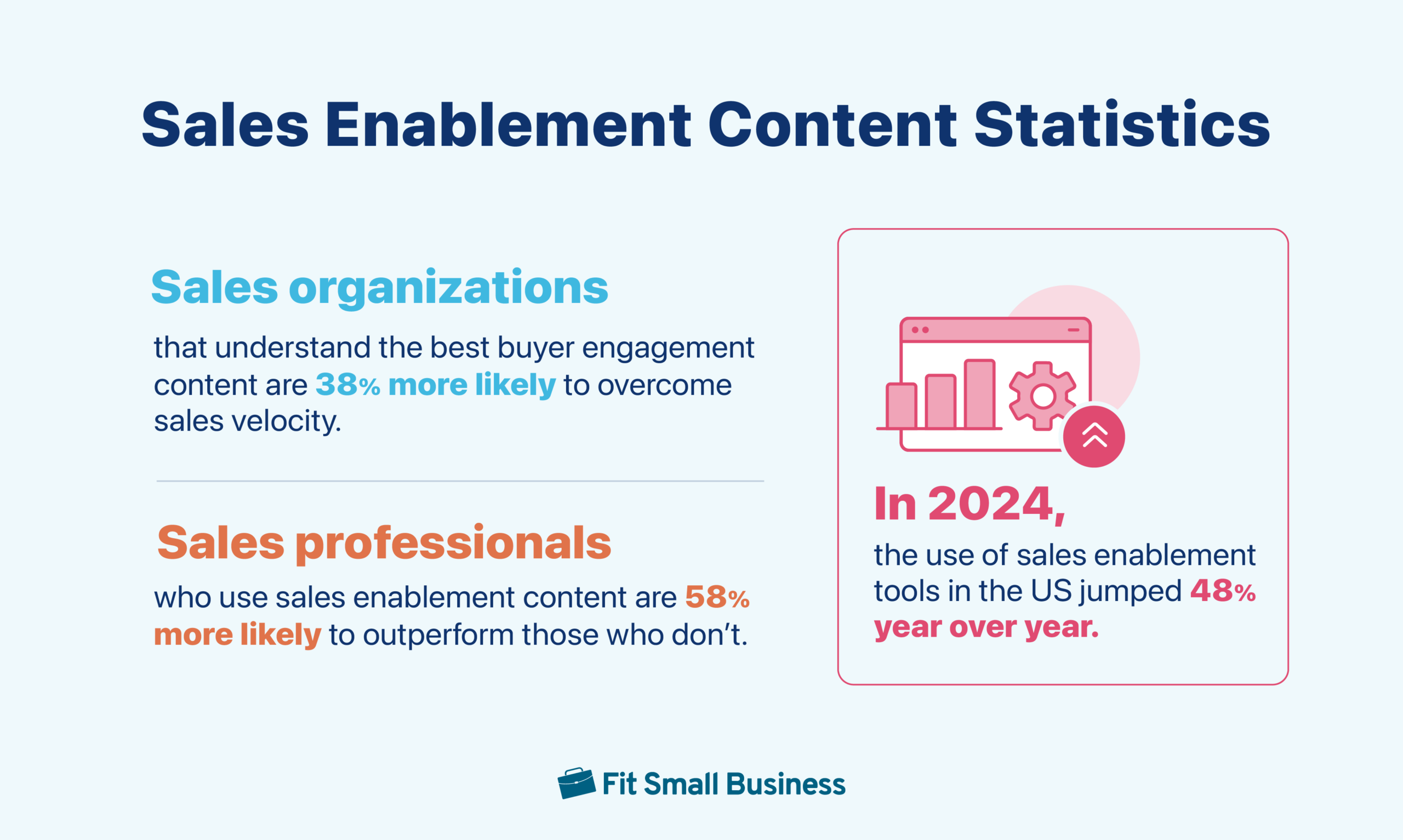
13. Sales professionals who use sales enablement content are 58% more likely to outperform those who don’t.
Takeaway: The best sales enablement content types to test include social media content, market research, reviews, customer testimonials, and product demos. If you have these content types, maximize their use during onboarding and employee training. This can help sales reps gain valuable insights into various sales data from marketing and customer service perspectives aside from sales.
(Source: HubSpot)
14. In 2024, the use of sales enablement tools in the US jumped 48% year over year.
Takeaway: Sales professionals are enthusiastic about using sales enablement content. When managers encourage sales reps to test varying sales enablement content types, they obtain relevant feedback that can help improve their sales performance. Investing in sales enablement tools and strategies that work helps create more sales pros who can also teach newbies effectively for the success of the overall sales team.
(Source: HubSpot)
15. Sales organizations that understand the best buyer engagement content are 38% more likely to overcome sales velocity.
Takeaway: Sales velocity measures how efficiently a sales team generates revenue. Sales reps can use CRMs with sales enablement tools like sales performance tracking, templates, and survey forms to create better selling strategies. Moreover, sales enablement helps managers and reps determine how prospects perceive content throughout the sales process to reduce sales friction and accelerate sales.
(Source: Sales Enablement Pro)
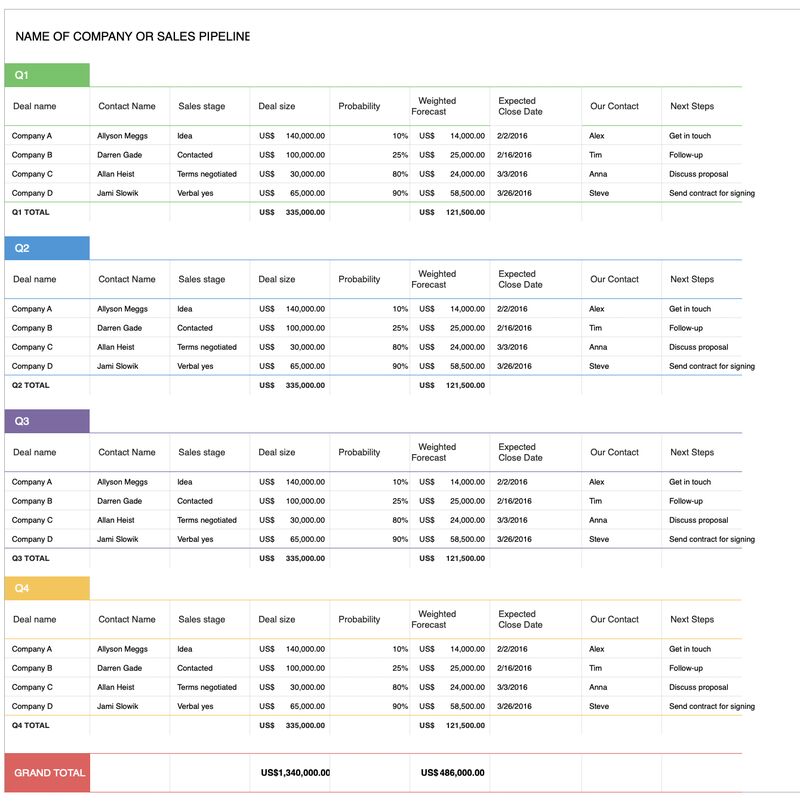
Pipedrive sales template helps teams track sales effectively. (Source: Pipedrive)
Sales Enablement Team Statistics
Enablement has grown in popularity in the last few years as more companies realize its value. Take a look at the stats below to see if your own team is on par with the trend and to know its impact on quota attainment.
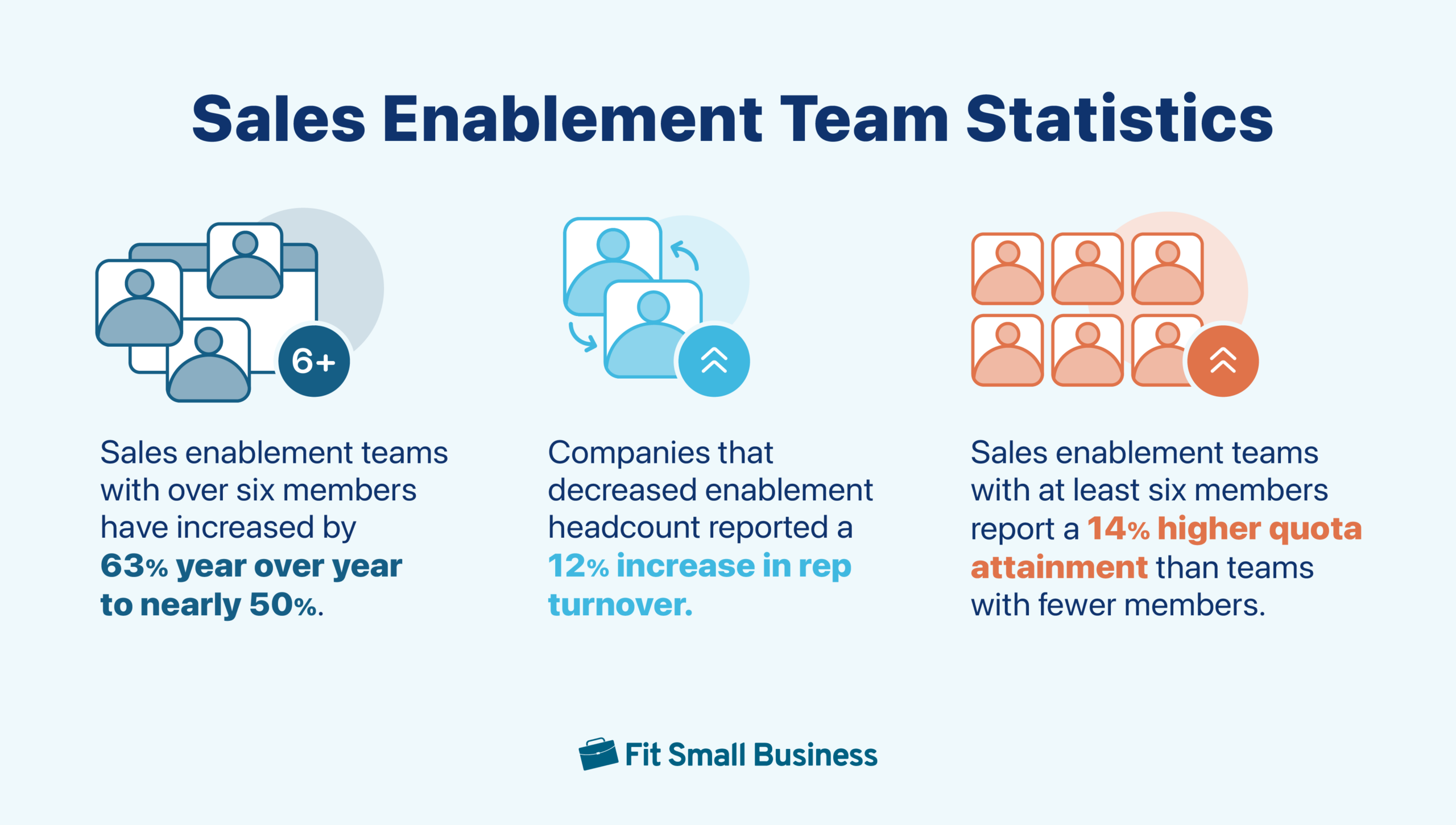
16. Sales enablement teams with over six members have increased by 63% year over year to nearly 50%.
Takeaway: The size of sales enablement teams has grown over the last few years. Some companies started with just a single team member assigned to this function and now have a team with over six members. This growth only shows that an increasing number of sales organizations are seeing the benefits of an enablement program.
(Source: Sales Enablement Pro)
17. Sales enablement teams with at least six members report a 14% higher quota attainment than teams with fewer members.
Takeaway: The size of a sales enablement team also impacts business results because well-trained reps tend to close more deals. If you want to meet or exceed your sales quota, you may want to add more members to your enablement team. Of course, you must consider your team’s budget before doing this. Brainstorm with your sales team monthly or quarterly to tackle this topic for a higher percentage of quota attainment.
(Source: Sales Enablement Pro)
18. Companies that decreased enablement headcount reported a 12% increase in rep turnover.
Takeaway: Businesses with more sales enablement reps leaving are likely to miss their chance of landing more sales. Hence, it’s crucial to have more well-trained sales reps in sales enablement trends, processes, and tools for accelerating revenue growth. Sales enablement training also ensures that they likely stay loyal to the company. They develop self-confidence to deliver the right message to prospects, resulting in more sales.
(Source: Sales Enablement Pro)
Sales Enablement Talent Management Statistics
Enablement can help a sales organization develop the right talent, make onboarding more efficient, and increase rep engagement. Read the statistics below to see the impact of enablement on talent management. Aside from sales enablement trends, there is also data on the latest performance metrics for salespeople.
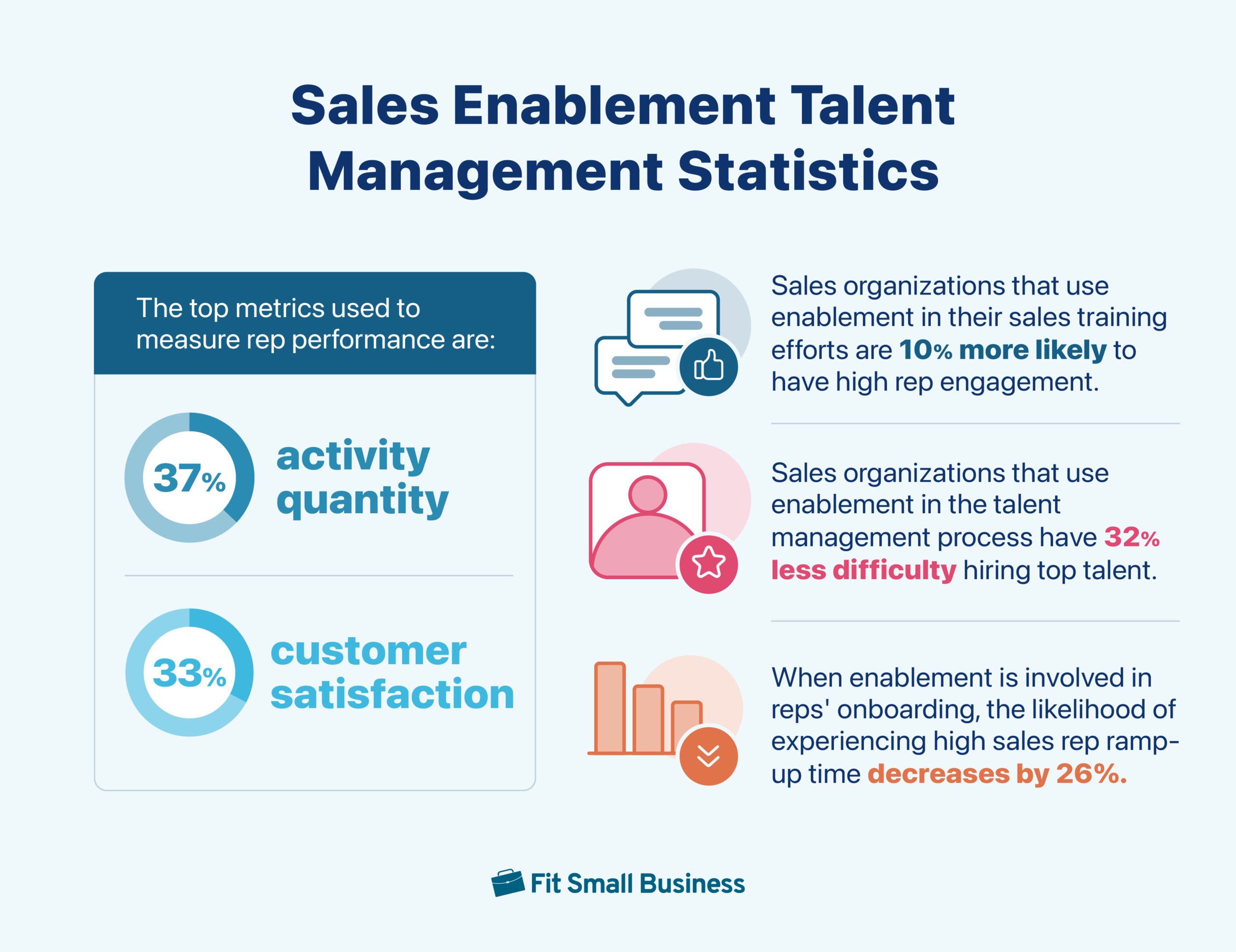
19. Sales organizations that use enablement in their sales training efforts are 10% more likely to have high rep engagement.
Takeaway: Use enablement during sales training, talent development, and onboarding sessions to prepare your sales reps for success. It empowers them to align their efforts with sales priorities. Furthermore, enablement-led sales training enables seasoned reps to share their best practices and real-life experiences with newbies. This promotes high engagement and good professional relationships among sales team members.
(Source: Sales Enablement Pro)
20. Sales organizations that use enablement in the talent management process have 32% less difficulty hiring top talent.
Takeaway: Enablement can help improve your talent acquisition process, laying out a clear pathway for new sales reps. It sets their expectations and provides necessary training. Sales managers can partner with human resources staff to help identify top sales talent. This practice can help set up reps for sales enablement success right from the beginning of their career with the company.
(Source: Sales Enablement Pro)
21. When enablement is involved in reps’ onboarding, the likelihood of experiencing high sales rep ramp-up time decreases by 26%.
Takeaway: Onboarding programs led by enablement minimize the time it takes for new sales reps to complete training and reach full productivity. Leveraging sales onboarding tools can also improve the overall onboarding experience of reps. All these factors contribute to the accelerated success of sales reps, enabling them to start contributing to the team’s overall performance and attainment of sales goals.
(Source: Sales Enablement Pro)
22. The top metrics used to measure rep performance are activity quantity (37%) and customer satisfaction (33%).
Takeaway: In 2020, the top metrics used to measure salesperson performance included quota attainment and customer retention. As the years passed, this shifted to customer satisfaction. Sellers now invest more in keeping customers happy for long-term business benefits like repeat purchases.
(Source: LinkedIn)
Frequently Asked Questions
According to a published Verified Market Research report, the 2023 sales enablement platform market size was valued at $3.41 billion. The market is also projected to reach $12.7 billion by 2030—growing at a compound annual growth rate of 19.70% from 2024 to 2030.
Sales organizations can measure the quantifiable results of sales enablement initiatives in terms of pipeline generation, quantity of closed deals, win rates, deal sizes, revenue acquisitions, and length of sales cycles. All of these metrics are directly related to the return on investment (ROI) of sales enablement.
Many sales organizations have shifted to using analytics tools in 2024. Sales and marketing teams usually analyze metrics and historical data to refine their sales enablement strategies. With analytics tools and artificial intelligence (AI), sales teams benefit from automation, predictive analytics, and generative assistants to accelerate sales enablement strategy development and implementation.
Bottom Line
Your sales team can expect continued improvement in business outcomes by implementing strategies based on sales enablement stats. You can refer to the data in this article when mapping out your sales plan to boost rep engagement and consistent sales performance. Companies must be updated with the latest sales enablement trends to ensure they deliver impactful business outcomes.